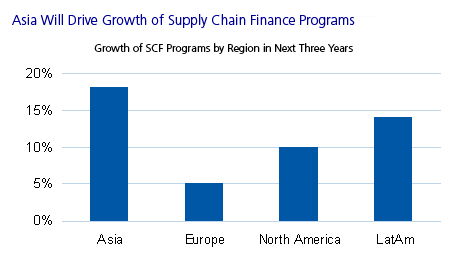Supply Chain Financing: Flavour of the Year?
Abstract
Supply chain financing is gradually gaining importance in monetizing open account transactions, thus ensuring an end-to-end financing solution for customers’ supply chains and enabling better visibility and activity management.
A constant increase in open account trading has put a lot of pressure on trade finance banks. The growth of open account trading has not only snatched the market away from banks, but has also hindered the visibility in customer’s trade activity management. This report, Supply Chain Financing: Flavour of the Year?, discusses the evolution of international trade patterns and trade finance business, shedding light on various approaches to supply chain finance (SCF) and the key role of financial institutions. The report aims to provide an understanding of market opportunities, revenue split, and technological evolution.
Asia is a clear growth area for SCF programs. Increasing growth in south-to-south transactions. The high level of intraregional trade within Asia will accelerate the growth of SCF programs in the region. SCF programs in Asia are expected to undergo an 18% increase in the next three years. SMEs that act as suppliers to global industralised nations will see an increased need for buyer-centric SCF programs against other industries looking for supplier-centric SCF programs.

“Implementing the right SCF model is key for avoiding future disappointments,” says Axel Pierron, Celent Senior Vice President and coauthor of the report. “Local and regional banks should carefully consider their SCF platform development strategy by evaluating the target market/s, type of industries to finance, and SCF programs to adopt. Local and regional banks have a clear role to play in supplier finance programs (receivables), where they can leverage their knowledge of local markets.”
“Increasing export volumes have prompted supplier demand for early financing in order to sustain growing business orders,” Prathima Rajan, Celent Analyst and coauthor of the report. “While receivables discounting and SCF have proved efficient for exporters working capital requirements, longer production and distribution cycles demand even earlier access to trade finance.”

